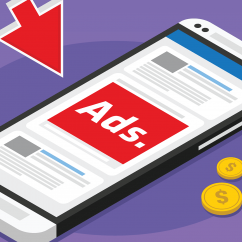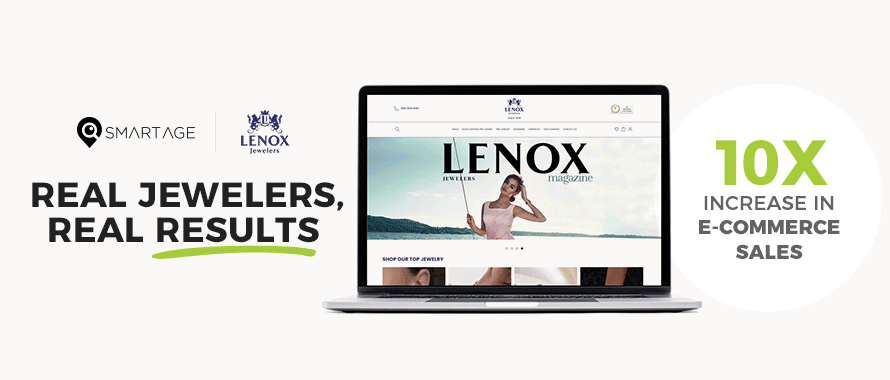Mobile Display Advertising For Jewelers: Delivering Your Message Straight to Consumers’ Pockets
August 26, 2018 (0 comments)

In my position as Director of Media, I oversee three media departments: Traditional, Digital and Social. My goal is to look at the full media mix and analyze how these different mediums can work together to create a well-rounded advertising approach. I try not to sway too much in either direction because from my perspective, all these mediums provide us with different touch points where we are able to access the consumer in a different setting and stage of the buying cycle. Think “Yin and Yang”, not “Either or”.
With that said, it is no secret that we spend more time than we’d like to admit on our mobile phones. Some surveys say we spend up to 75 hours every month browsing on our smart devices, and even that is probably cutting ourselves short! I believe it is safe to say that this is also a growing number as we move more and more into a generation of instant gratification and consolidation. How’s this for a “hot take” – not only are most consumers spending more time in front of their mobile phones than their TV or Radio…. Many of those same consumers are electing to view or listen to their desired content on their mobile phones as well!
As advertisers, we have the choice to either ride the wave or try to withstand the hit. Some dare to anticipate the wave with innovation, others dig their feet in the sand and eventually find themselves gasping for air. The reaction I’ve seen from retailers when I talk about mobile advertising can be summed up in to one sentence: “This is music to my ears as an advertiser, but scary as hell as a consumer”. In the end, we all play the role of both, so finding a balance in our judgement of how we choose to advertise is key.
I strongly recommend all retail jewelers take a step out of their comfort zone and try to ride the wave of Mobile Display. Each smart device carries tons of data that can be used to create tailored audiences for your message; based on where those consumers have been both online and in the real world. By definition, Mobile Display can be summarized as the delivery of display ads to consumers on their mobile devices (smart phones and tablets), through placement on both mobile apps and mobile sites. There is obviously much more to it, so I broke out a few bullet points to help simplify this advertising medium!
Quick Tips & Industry Insights:
-Mobile Display works best when in proximity to your store locations. Don’t veer too far from home! Users are most likely to convert off a mobile display ad when delivered an impression within a 10-15-mile radius of your store (this is an average we’ve taken from over 100 media markets, there are circumstantial variables that would dictate a larger radius such as population scale and competition index).
The current industry demand for display impressions has a strong lean towards in-app delivery, usually in-feed. Many industry experts suggest that in the near future, smart phones will no longer carry default browsers and mobile content will be fully segmented by mobile apps. Get ahead of the ball by focusing your impression delivery heavily towards mobile apps!
Static banners are a thing of the past. We strongly recommend using either GIF or HTML5 animation; as we’ve seen up to 40% higher engagement with those formats in comparison to static banners.
Keep it simple! Simple animation, simple ad copy, no more than one or two creative rollouts each month. In order to increase engagement with your consumers, you need to build frequency behind the message before spreading your voice to thin! Also, remember the purpose of your ad is to grab the consumer’s attention and drive them to a landing page where they can digest your message in a much cleaner, user-friendly setting.
Beware of ad fraud – choose your partners wisely! Many studies show that programmatic buying platforms can drive up to 5x higher ad fraud than a manual buying platform. As a retailer, you likely don’t have time to do all of this yourself and trying to hire an in-house Advertising Director with the skill set to execute high-level campaigns can prove to be costly. This is why we always recommend you partner up with an agency that works with a verified DSP (Demand Side Platform) to ensure you are receiving what you are paying for. TAG (Trustworthy Accountability Group) is a global third-party auditor which certifies DSP’s for their accuracy and transparency in the digital advertising industry. Some of the world’s largest advertisers, including Proctor & Gamble (largest advertiser in the world at $4B annual ad spend), will only work with a DSP that is certified by TAG. You should follow suit!
At Bottom Line Marketing, we leverage our relationships some of the largest demand side platforms on the globe to create unique campaigns tailored to each one of our clients using both 1st and 3rd party location and behavioral data. With that data, we are able to deliver mobile ads to your exact audience, build dynamic mobile landing pages with click-to-call and click-to-map capabilities, and use blueprint technology to record store visitation driven directly from your mobile ads. If you are interested in learning more, give us a call!
 In my position as Director of Media, I oversee three media departments: Traditional, Digital and Social. My goal is to look at the full media mix and analyze how these different mediums can work together to create a well-rounded advertising approach. I try not to sway too much in either direction because from my perspective, all these mediums provide us with different touch points where we are able to access the consumer in a different setting and stage of the buying cycle. Think “Yin and Yang”, not “Either or”.
With that said, it is no secret that we spend more time than we’d like to admit on our mobile phones. Some surveys say we spend up to 75 hours every month browsing on our smart devices, and even that is probably cutting ourselves short! I believe it is safe to say that this is also a growing number as we move more and more into a generation of instant gratification and consolidation. How’s this for a “hot take” – not only are most consumers spending more time in front of their mobile phones than their TV or Radio…. Many of those same consumers are electing to view or listen to their desired content on their mobile phones as well!
As advertisers, we have the choice to either ride the wave or try to withstand the hit. Some dare to anticipate the wave with innovation, others dig their feet in the sand and eventually find themselves gasping for air. The reaction I’ve seen from retailers when I talk about mobile advertising can be summed up in to one sentence: “This is music to my ears as an advertiser, but scary as hell as a consumer”. In the end, we all play the role of both, so finding a balance in our judgement of how we choose to advertise is key.
I strongly recommend all retail jewelers take a step out of their comfort zone and try to ride the wave of Mobile Display. Each smart device carries tons of data that can be used to create tailored audiences for your message; based on where those consumers have been both online and in the real world. By definition, Mobile Display can be summarized as the delivery of display ads to consumers on their mobile devices (smart phones and tablets), through placement on both mobile apps and mobile sites. There is obviously much more to it, so I broke out a few bullet points to help simplify this advertising medium!
In my position as Director of Media, I oversee three media departments: Traditional, Digital and Social. My goal is to look at the full media mix and analyze how these different mediums can work together to create a well-rounded advertising approach. I try not to sway too much in either direction because from my perspective, all these mediums provide us with different touch points where we are able to access the consumer in a different setting and stage of the buying cycle. Think “Yin and Yang”, not “Either or”.
With that said, it is no secret that we spend more time than we’d like to admit on our mobile phones. Some surveys say we spend up to 75 hours every month browsing on our smart devices, and even that is probably cutting ourselves short! I believe it is safe to say that this is also a growing number as we move more and more into a generation of instant gratification and consolidation. How’s this for a “hot take” – not only are most consumers spending more time in front of their mobile phones than their TV or Radio…. Many of those same consumers are electing to view or listen to their desired content on their mobile phones as well!
As advertisers, we have the choice to either ride the wave or try to withstand the hit. Some dare to anticipate the wave with innovation, others dig their feet in the sand and eventually find themselves gasping for air. The reaction I’ve seen from retailers when I talk about mobile advertising can be summed up in to one sentence: “This is music to my ears as an advertiser, but scary as hell as a consumer”. In the end, we all play the role of both, so finding a balance in our judgement of how we choose to advertise is key.
I strongly recommend all retail jewelers take a step out of their comfort zone and try to ride the wave of Mobile Display. Each smart device carries tons of data that can be used to create tailored audiences for your message; based on where those consumers have been both online and in the real world. By definition, Mobile Display can be summarized as the delivery of display ads to consumers on their mobile devices (smart phones and tablets), through placement on both mobile apps and mobile sites. There is obviously much more to it, so I broke out a few bullet points to help simplify this advertising medium!


